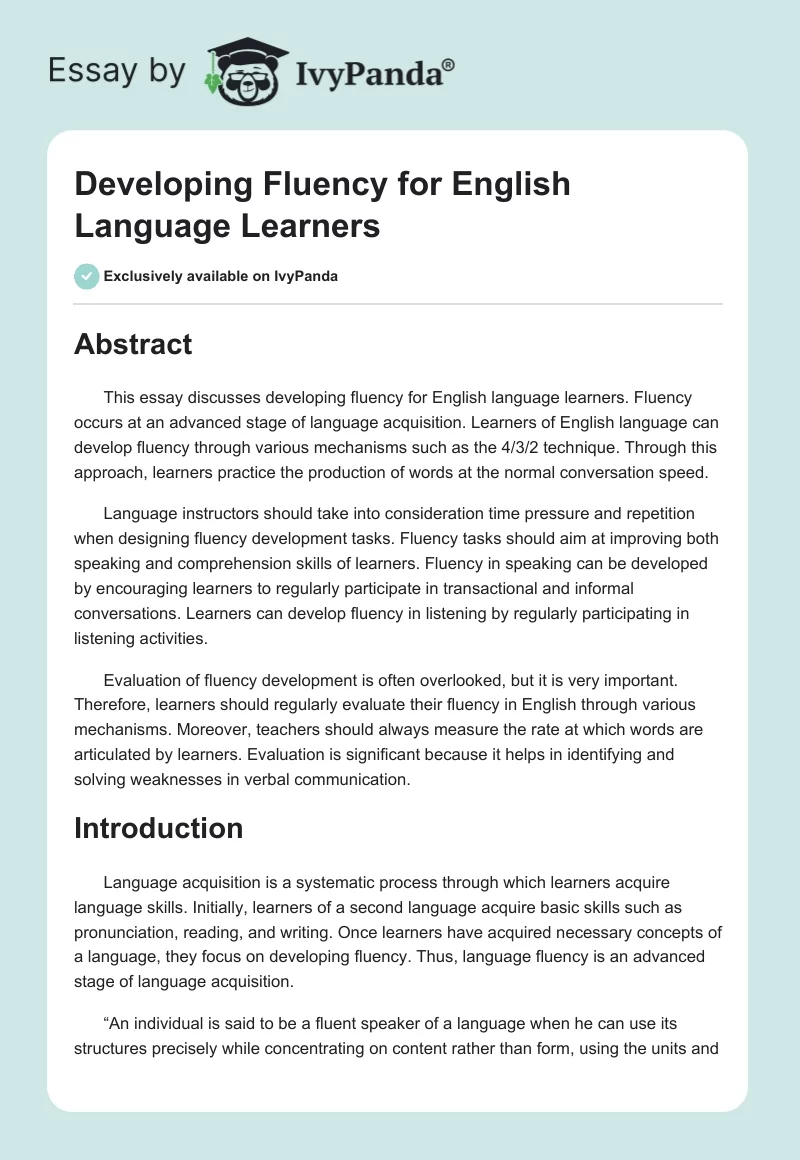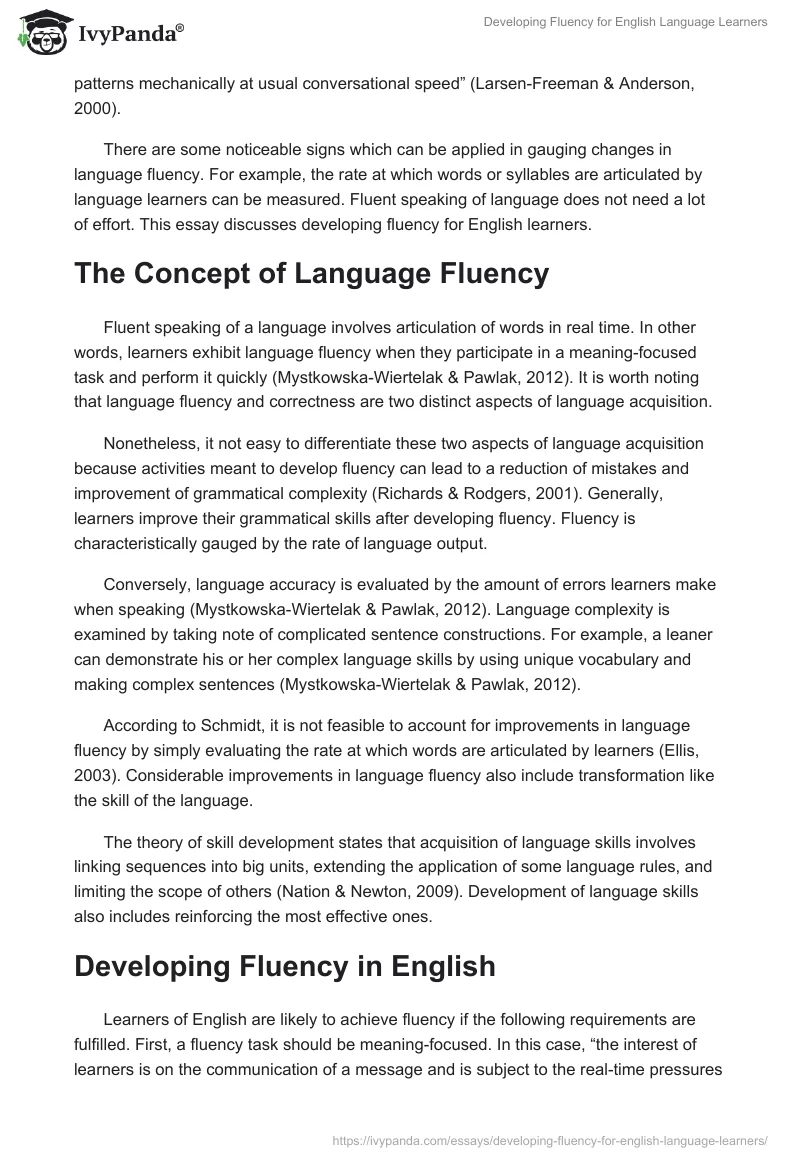Abstract
This essay discusses developing fluency for English language learners. Fluency occurs at an advanced stage of language acquisition. Learners of English language can develop fluency through various mechanisms such as the 4/3/2 technique. Through this approach, learners practice the production of words at the normal conversation speed.
Language instructors should take into consideration time pressure and repetition when designing fluency development tasks. Fluency tasks should aim at improving both speaking and comprehension skills of learners. Fluency in speaking can be developed by encouraging learners to regularly participate in transactional and informal conversations. Learners can develop fluency in listening by regularly participating in listening activities.
Evaluation of fluency development is often overlooked, but it is very important. Therefore, learners should regularly evaluate their fluency in English through various mechanisms. Moreover, teachers should always measure the rate at which words are articulated by learners. Evaluation is significant because it helps in identifying and solving weaknesses in verbal communication.
Introduction
Language acquisition is a systematic process through which learners acquire language skills. Initially, learners of a second language acquire basic skills such as pronunciation, reading, and writing. Once learners have acquired necessary concepts of a language, they focus on developing fluency. Thus, language fluency is an advanced stage of language acquisition.
“An individual is said to be a fluent speaker of a language when he can use its structures precisely while concentrating on content rather than form, using the units and patterns mechanically at usual conversational speed” (Larsen-Freeman & Anderson, 2000).
There are some noticeable signs which can be applied in gauging changes in language fluency. For example, the rate at which words or syllables are articulated by language learners can be measured. Fluent speaking of language does not need a lot of effort. This essay discusses developing fluency for English learners.
The Concept of Language Fluency
Fluent speaking of a language involves articulation of words in real time. In other words, learners exhibit language fluency when they participate in a meaning-focused task and perform it quickly (Mystkowska-Wiertelak & Pawlak, 2012). It is worth noting that language fluency and correctness are two distinct aspects of language acquisition.
Nonetheless, it not easy to differentiate these two aspects of language acquisition because activities meant to develop fluency can lead to a reduction of mistakes and improvement of grammatical complexity (Richards & Rodgers, 2001). Generally, learners improve their grammatical skills after developing fluency. Fluency is characteristically gauged by the rate of language output.
Conversely, language accuracy is evaluated by the amount of errors learners make when speaking (Mystkowska-Wiertelak & Pawlak, 2012). Language complexity is examined by taking note of complicated sentence constructions. For example, a leaner can demonstrate his or her complex language skills by using unique vocabulary and making complex sentences (Mystkowska-Wiertelak & Pawlak, 2012).
According to Schmidt, it is not feasible to account for improvements in language fluency by simply evaluating the rate at which words are articulated by learners (Ellis, 2003). Considerable improvements in language fluency also include transformation like the skill of the language.
The theory of skill development states that acquisition of language skills involves linking sequences into big units, extending the application of some language rules, and limiting the scope of others (Nation & Newton, 2009). Development of language skills also includes reinforcing the most effective ones.
Developing Fluency in English
Learners of English are likely to achieve fluency if the following requirements are fulfilled. First, a fluency task should be meaning-focused. In this case, “the interest of learners is on the communication of a message and is subject to the real-time pressures and demands of meaning-focused communication” (Mystkowska-Wiertelak & Pawlak, 2012). Second, learners can develop fluency if they participate in speaking tasks in which they are familiar with verbal communication items.
This implies that learners practice familiar themes and types of dialogue by applying vocabulary and structures they have already acquired. These kinds of tasks are called experience activities because learners already possess the necessary skills needed to perform them (Ellis, 2003). Third, learners should be motivated to speak fluently.
Activities aimed at achieving fluency in English should be organized in a manner that motivates learners to talk quickly. In other words, fluency tasks should deliberately compel learners to perform speaking activities quickly.
Learners of English language need several formal and informal opportunities to participate in meaning-focused activities. If learners fail to practice the English skills they have acquired, they cannot develop fluency (Mystkowska-Wiertelak & Pawlak, 2012).
Designing English Fluency Tasks
Instructors should design English fluency tasks that are convenient for learners. One of the commonly used fluency development techniques is called 4/3/2 activity. It involves making learners perform speaking tasks in pairs with one learner acting as an orator and the other as an audience.
In this technique, a leaner can talk for four minutes on a given topic, and his or her colleague listens. After the first activity, the pairs change roles and repeat the initial task within three minutes. After the second presentation, the pairs change roles again and perform the same speaking task within two minutes. This fluency development technique has three significant characteristics.
First, the learner is motivated to process a huge amount of words. This is achieved by allowing the orator to make three talk presentations without interference. Second, “the demands of the tasks are limited to a much smaller set than would occur in most uncontrolled learning activities” (Ellis, 2003). In the 4/3/2 technique of developing English fluency, the speaker identifies ideas and verbal communication items and plans the talk.
The four and three minutes presentations enable the orator to control language items. This makes fluency of English an important goal of the speaking task. It is important to note that the repetition of a speaking task makes a leaner attentive (Richards & Rodgers, 2001). Third, the repetition of a speaking task enables learners to perform well. Moreover, the gradual decreasing of time for output motivates learners to speak fluently.
Developing Fluency in Listening
Although most fluency development tasks focus on skill development, they inexorably influence knowledge of English. In listening and reading tasks, “a distinction is sometimes made between activities where a leaner brings a lot of topic-related background knowledge to the task (top-down processing) and activities where a leaner relies primarily on the language of the text understand (bottom-up processing)” (Nation & Newton, 2009).
Most comprehension tasks are a mixture of these two techniques, but one is often dominant. Fluency activities should be mainly top-down processing since they allow learners of English to perform quickly.
Top-down processing can be facilitated by making learners listen to themes familiar to them. Conversely, “bottom-up processing takes place when the major source of information is the text itself, and the audience cannot rely on previous experience to assist in comprehension” (Harmer, 2001). These two approaches to developing fluency in listening can be implemented through the following tasks.
In the identification task, the instructor mentions some sentences that explain something. The learners respond to the question by writing or mentioning the name of the described item. The learners should be familiar with the items described by the instructor. Listening to questions facilitate the development of fluency in listening.
For example, a teacher can ask students questions about items in the learning environment, such as pictures and books. A teacher should randomly ask students to answer questions to make them attentive.
Blown-up books approach can facilitate the teaching of reading skills (Harmer, 2001). Blown-up books are often huge and contain many pictures. In this case, a teacher reads a story in class, and learners try to connect it with the pictures in the books. In other words, pictures can be used to facilitate the development of listening and comprehension skills.
Another listening activity involves getting learners to listen to tapes of what they have previously read in class. Students should be encouraged to take notes during listening sessions. After a listening activity, an instructor can ask learners to answer questions based on what they have heard.
Developing Fluency in Speaking
Fluency in speaking is an important aspect of learning English. Fluency in speaking English can be achieved effectively through the following tasks. Most verbal communication tasks aimed at developing fluency in English involve rehearsal and repetition of speaking activities (Larsen-Freeman & Anderson, 2000). The following speaking activities can be used when the 4/3/2 technique is applied to developing fluency in English.
The best recording approach is a significant fluency activity in which a learner records his speaking task and later listens to the recording to identify his weaknesses in verbal communication. This activity can be done several times until a learner speaks English fluently. Repetition of similar tasks gives learners an opportunity to improve fluency. This technique requires proper planning of speaking tasks (Harmer, 2001).
The second activity is called ask and answer approach. In this approach, learners read a story intensively. After reading, they carry out speaking tasks in pairs by asking each other questions related to the story they have read. This fluency task enables learners to develop fluency in comprehension, to listen, and to speak. Hence, learners of English should regularly practice it (Richards & Rodgers, 2001).
Rehearsal of a talk enables a learner to understand a given topic properly before presenting it to a formal audience. “Rehearsed talks involve learners using the pyramid procedure of preparing a talk individually, rehearsing it with a partner, practicing it in a small group, and then presenting it to the whole class” (Mystkowska-Wiertelak & Pawlak, 2012).
Through systematic rehearsal, a learner can eliminate many errors before the actual fluency task. Thus, it leads to fluency in speaking English. Additionally, “learners may keep a regular record of how long it takes them to perform a fluency task, and try to accomplish a given task quickly” (Larsen-Freeman & Anderson, 2000).
Monitoring Fluency Tasks
Fluency development tasks should be evaluated regularly to determine the progress of learners in learning English. Regular monitoring of speaking tasks helps teachers to identify factors that hinder learners from communicating fluently.
For example, instructors should regularly measure the rate of speech production by learners. This will enable them to determine the changes in fluency development in learners. Thus, evaluation of fluency tasks assists teachers in designing appropriate fluency tasks (Larsen-Freeman & Anderson, 2000).
Conclusion
It is evident from this study that the development of fluency is an important aspect of learning English. Fluency activities enable learners to develop good speaking, comprehension, and reading skills. Learners can develop fluency in English through various approaches and activities depending on their levels of education and reasons for learning English.
Activities aimed at improving fluency in English should be designed to encourage learners to speak efficiently. Fluency activities should be meaning-focused and should be based on language items and themes that learners already understand. Last, learners should continuously practice fluency tasks because repetition enhances competence in language production and comprehension.
References
Ellis, R. (2003). Task-based Language Learning and Teaching. Oxford: Oxford University Press.
Harmer, J. (2001). The Practice of English Language Teaching. New York: Longman.
Larsen-Freeman, D., & Anderson, M. (2000). Techniques and Principles in Language Teaching. Oxford: Oxford University Press.
Mystkowska-Wiertelak, A., & Pawlak, M. (2012). Production-Oriented and Comprehension- Based Grammar Teaching in the Foreign Language Classroom. New York: Springer.
Nation, I., & Newton, J. (2009). Teaching ESL/EFL Listening and Speaking. London: Routledge.
Richards, J., & Rodgers, T. (2001). Approaches and Methods in Language Teaching. New York: Cambridge University Press.


